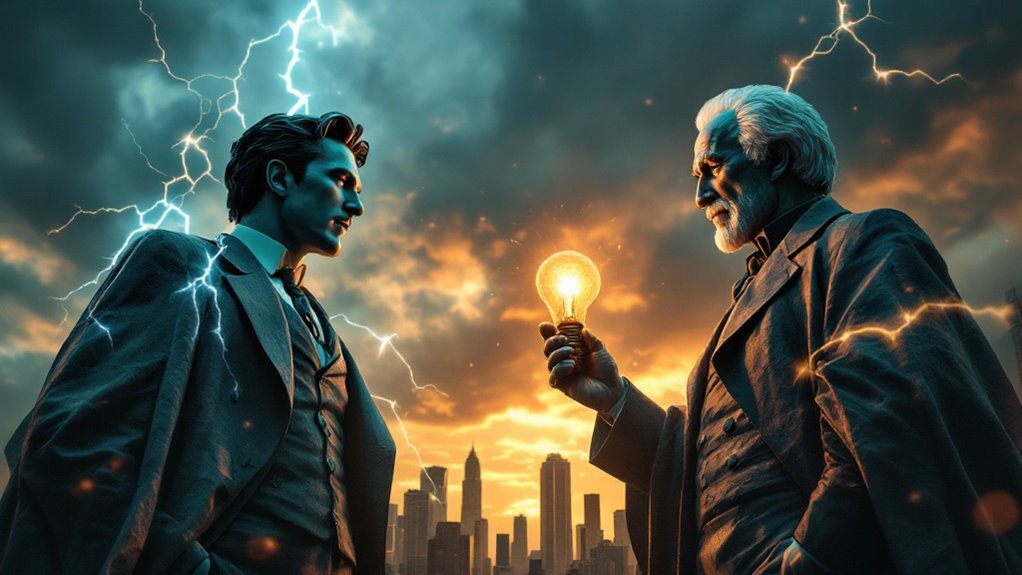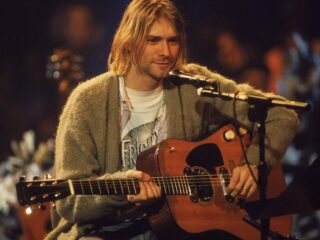Let’s explore the world of Tesla with his visionary ideas and Edison with his relentless drive; their rivalry is a catalyst for the modern electrical age. You’re about to uncover how their feud, centered around AC and DC currents, wasn’t merely a clash of personalities but a battle that propelled technological progress.
As you navigate through their business tactics and public perceptions, you’ll start to see how their innovations left a lasting impact. What secrets about their rivalry await to be discovered, and how did it shape the future of electricity?
Early Lives and Careers
The early lives and careers of Nikola Tesla and Thomas Edison set the stage for their legendary rivalry. Envision growing up in the Austrian Empire, like Tesla, with a father who wanted you to become a minister, while your mom was busy inventing household gadgets.
Despite these childhood influences, Tesla’s heart was set on science. He initiated an educational path through the Austrian Polytechnic Institute, diving into mechanical and electrical engineering. Although his journey at the University of Prague was cut short, Tesla didn’t let that stop him. His bright mind soon found him working in Budapest, Paris, and Strasbourg, with his revolutionary idea for the induction motor sparking in Budapest. An influential moment in Tesla’s early life was his realization of the potential of alternating electric currents, which later became a cornerstone of his innovations.
Now, picture Edison, born in Ohio, who practically invented the concept of being a self-taught genius. With limited formal schooling, his mom became his educator. Edison’s educational path was unconventional, marked by reading and relentless experimentation.
Starting as a telegraph operator, he made waves with his improved stock ticker and went on to establish the Edison Electric Light Company. His Menlo Park lab, the “Invention Factory,” churned out innovations. Edison’s early career reflected his inventive spirit, setting the stage for the electrifying clash to come.
Clash of Electrical Currents
During the late 19th century, the battle between alternating current (AC) and direct current (DC) electrified the world, sparking a fierce rivalry between Nikola Tesla and Thomas Edison. Envision it: Tesla, the visionary, championing AC with its superior power efficiency and remarkable voltage conversion capabilities.
Meanwhile, Edison clung stubbornly to DC, despite its glaring transmission challenges and DC limitations. In this historical context, AC offered clear advantages with its ability to efficiently transmit electricity over long distances. It quickly became apparent that AC could set new electrical standards. Edison’s DC systems initially faced significant limitations due to power loss during transmission over long distances, which made AC, with its adaptability, the preferred choice.
Edison, not one to back down easily, orchestrated dramatic public campaigns to discredit AC. His antics ranged from misleading demonstrations to the grim introduction of the electric chair using AC, all to instill fear. Despite Edison’s efforts, AC’s practicality for power distribution ultimately won out. The Chicago World’s Fair and the Niagara Falls Power Project highlighted AC’s triumph, illustrating its efficiency over vast distances with fewer power stations needed.
Business Alliances and Strategies

Stepping into the domain of business alliances and strategies, Tesla’s partnerships have played a pivotal role in its journey to becoming a leader in the electric vehicle market. Envision Tesla as a scrappy underdog, teaming up with automotive giants like Daimler AG and Toyota.
These strategic partnerships were like a lifeline, providing Tesla with essential resources and expertise. Daimler’s $50 million investment in 2009 was a game-changer, offering engineering prowess that helped Tesla overcome early hurdles. Meanwhile, the collaboration with Toyota not only gifted Tesla the NUMMI factory but also a masterclass in lean manufacturing. It’s like learning karate from Mr. Miyagi—wax on, wax off, but with cars.
Fast forward to 2024, and Tesla’s alliances have evolved to focus on resource optimization and market expansion. Partnering with Ford and GM to open its Supercharger network is like inviting neighbors over for a barbecue—everyone’s happy, and you get to show off your grill skills.
These partnerships are predicted to generate up to $12 billion annually by 2030, proving that sharing is indeed caring. By strengthening its brand and expanding its reach, Tesla’s strategic alliances fuel its vision of a sustainable future. Tesla’s partnership with Panasonic, where they established a dedicated Gigafactory for battery production, exemplifies its forward-thinking approach to meeting the high demand for electric vehicles.
Public Safety and Perception
In the battle between Tesla and Edison, public safety and perception played a crucial role in shaping the future of electrical power. Edison’s fear-mongering campaigns were downright theatrical! He went to great lengths, even electrocuting animals and supporting the electric chair’s creation, all to instill public fear about Tesla’s alternating current (AC).
By using media propaganda, he painted AC as a lurking danger, and initially, the public bought into it, imagining AC as some sort of invisible monster lurking in their homes. But Tesla, ever the showman and scientist, countered with safety education and live demonstrations.
Picture him lighting up a string of bulbs or even sending AC through his own body with a flourish! It was like he was saying, “Look, even I can handle this!” His efforts at the Chicago World’s Fair and Niagara Falls were nothing short of electrifying, turning the tide of public perception.
Tesla’s public demonstrations proved AC power’s safety and viability, which helped in shifting the public’s opinion. Eventually, the media’s tune changed, highlighting AC’s benefits and safety. This shift led to widespread acceptance and regulatory advances, ensuring safety measures were put in place. Tesla’s spark of ingenuity genuinely illuminated the path to modern electrification.
Key Innovations and Projects
Often overlooked in the grand fabric of electrical innovation are the groundbreaking contributions of Nikola Tesla and Thomas Edison, which fundamentally shaped modern technology. Let’s explore their key innovations and projects! Y
ou’ve got Tesla, the genius behind the alternating current (AC) motor, which turned power systems on their head. His invention allowed electricity to travel long distances without losing much energy, thanks to those nifty transformers that could juggle voltage up or down. Visualize this: Tesla’s AC system effectively lit up entire cities, making previous power stations as outdated as yesterday’s newspaper.
Now, let’s not forget Edison, who had a knack for sound technology. He invented the phonograph, a device that captured sound and changed the music game forever. Consider living in a world where you couldn’t just pop in your earbuds and jam out! Edison’s work laid the foundation for our modern audio systems, creating a symphony of possibilities.
Their conflict symbolizes the broader dichotomy between innovation and commercial interests, a theme that continues to influence modern technological advancements and public perception.
Between Tesla’s electrifying AC power distribution and Edison’s sound innovations, these two titans weren’t just lighting up the world; they were setting the stage for a technological symphony that still resonates today. Who knew rivalry could be this electrifying?
The Chicago World’s Fair Impact
The Chicago World’s Fair of 1893 flipped the script on electrical technology, showcasing the groundbreaking power of Nikola Tesla’s alternating current (AC) system. Envision walking into a dazzling wonderland, illuminated by over 200,000 light bulbs—a true electrical spectacle! T
his fair was a stage for fair innovations that reshaped the future. George Westinghouse, armed with Tesla’s AC technology, underbid Edison’s General Electric Company, clinching the lighting contract for $399,000. Edison’s response? He refused to sell light bulbs to Westinghouse, which was a bit like a sore loser refusing to share their toys.
As you strolled the fairgrounds, giant searchlights cut through the night sky, visible from sixty miles away. The Manufactures and Liberal Arts Building twinkled with white bulbs, making the place look like a scene from a fairy tale—except it was real and powered by AC.
This fair consumed three times more electricity than the entire city of Chicago at the time! The 27 million visitors were not just entertained; they were educated. Tesla’s engaging talks revealed the magic behind AC, marking a pivotal moment in the AC-DC battle and setting the stage for AC’s triumph. The fair not only demonstrated the viability of AC power but also solidified its role in the future of electrical systems worldwide.
Niagara Falls: The AC Triumph

You might chuckle at the thought of Edison shaking his head as Tesla’s triumph solidified the AC revolution. This victory was part of the “war of the currents,” where Tesla and George Westinghouse promoted alternating current (AC) over Edison’s direct current (DC). Today, a bronze monument of Tesla overlooks the Falls, a tribute to his visionary work. The Niagara power project stands as a victory for innovation and the relentless pursuit of progress.
Media Influence on the Rivalry
In between the lines of history, media played a crucial role in shaping the Tesla vs. Edison rivalry. The press, hungry for stories, often painted this competition as a dramatic battle of personalities, each article a brushstroke in the epic tale of innovation.
Media sensationalism turned a technical debate into a public spectacle, manipulating perceptions and making it seem more personal than it genuinely was. Newspapers and journals constantly asked, “Who is king, Edison or Tesla?” This question wasn’t just about electricity; it was about engrossing readers with a story of genius versus pragmatism. The current wars were primarily commercial disputes rather than personal vendettas, yet media coverage often sensationalized their rivalry, creating a narrative that pitted the two inventors against each other on a deeply personal level.
Edison wasn’t above using media to his advantage. He orchestrated alarming demonstrations, electrocuting animals to showcase the supposed dangers of Tesla’s AC. His articles warned of AC’s threats, aiming to scare the public into favoring his DC. It was a circus, quite literally! Meanwhile, George Westinghouse, Tesla’s ally, harnessed the media’s power to counter these smear campaigns. With successful public demonstrations, like those at the 1893 Chicago World’s Fair, Westinghouse highlighted AC’s benefits, swaying public opinion.
Thus, the media didn’t just report on the rivalry; it fueled it, ensuring the saga of Tesla and Edison would enthrall generations.
Lasting Legacies of Both Inventors

Conceive a world without electricity lighting up cities, powering communication, or driving innovation. It’s hard to visualize, right? Yet, Nikola Tesla and Thomas Edison shaped this reality.
Tesla’s Alternating Current (AC) system revolutionized how electricity was transmitted, making it the global standard and illuminating the world as we perceive it. His foresight in wireless communication and renewable energy has left an indelible cultural impact, sparking inspiration for modern technologies like radio, Wi-Fi, and sustainable power sources.
Tesla’s dream for harnessing natural forces continues to push today’s renewable energy initiatives, reminding us that he was a genius ahead of his time. Despite the financial struggles Tesla faced, his vision of global wireless energy continues to inspire future innovations in wireless technology.
But let’s not forget Edison, the quintessential inventor-entrepreneur. His practical inventions, like the light bulb and phonograph, transformed everyday life. Edison’s innovation factories, which churned out patents like a baker churns out cookies, revolutionized the way we think about research and development.
With over a thousand patents, he was the original multitasker. Together, these two titans of invention didn’t just change the world; they electrified it. Their legacies continue to inspire and shape how we approach innovation and sustainability today. Quite the dynamic duo, wouldn’t you say?
Technological Advancements Driven by Feud
The rivalry between Tesla’s AC and Edison’s DC systems wasn’t just a clash of personalities but a catalyst for significant technological advancements. Envision the world as a stage, with Tesla’s AC efficiency taking the spotlight. AC could transmit electricity over long distances with little energy loss, unlike DC’s limitations that required power stations everywhere, like a bad case of urban acne.
Tesla’s public demonstrations, particularly at the Chicago World’s Fair and Niagara Falls, electrified audiences and showcased how AC met industrial needs with grace and power. Tesla’s innovation was further supported by George Westinghouse, who recognized the efficiency of AC for long-distance transmission and partnered with Tesla to promote its widespread adoption.
As cities lit up with AC’s glow, the economic implications were enormous. Fewer power stations meant lower costs and more money for, well, more light bulbs! The AC system’s ability to use transformers for distributing power at various voltages made it versatile, like a gymnast in a power grid. Meanwhile, DC’s energy loss and safety concerns kept it on the sidelines.
Tesla’s visionary work didn’t stop there; his dabbling in wireless communication laid the groundwork for what would become the Internet’s great-great-grandparent. Plus, his hydroelectric power projects proved AC’s prowess in powering entire regions, making Tesla and his ideas shine brightly in the history of innovation.
Wrapping up
Let’s say you’re watching a thrilling chess game where each move changes the world. In one corner, you’ve got Edison with his steadfast DC strategy, like a knight protecting its ground. Across the board, Tesla dazzles with his nimble, far-reaching AC, akin to a queen sweeping across the board. Their fierce rivalry electrified the world and sparked innovations that light up our lives today. So, next time you flip a switch, remember, you’re witnessing the legacy of their epic showdown.



